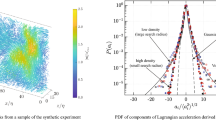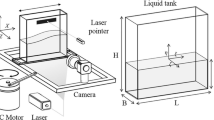Abstract
We present an imaging method aimed at measuring the transient three-dimensional topography of rapidly deforming opaque surfaces. The imaging setup features a laser stripe scanned repeatedly across the surface using a spinning wheel with mirror facets. Acquisition rates of 20 scans per second are attained by spinning the wheel rapidly and imaging the resulting stripes using a fast camera. The algorithms adopted to capture the stripes, reconstruct the surface topography for each scan, and calibrate the camera and laser configuration are described. Error estimates for successive steps are evaluated and compared to results from repeat and independent measurements of the final deposit shape. The method is then used to acquire time-resolved measurements of small-scale debris flows. Specifically, we measure the free-surface topography of debris surges as they flow across an idealized canyon–fan transition. In addition to profiling the final deposit shape, the method successfully resolves the transient evolution of the free surface. Applied to textured surfaces, the method can also be combined with particle tracking velocimetry.
















Similar content being viewed by others
References
Ancey C (2001) Debris flows and related phenomena. In: Balmforth NJ, Provenzale A (eds) Geomorphological fluid mechanics. Lecture Notes in Physics 582: 528–547
Arattano M, Marchi L (2008) Systems and sensors for debris-flow monitoring and warning. Sensors 8:2436–2452
Arattano M, Marchi L, Cavalli M (2012) Analysis of debris-flow recordings in an instrumented basin: confirmations and new findings. Nat Hazards Earth Syst Sci 12:679–686
Astruc D, Cazin S, Cid E, Eiff O, Lacaze L, Robin P, Toublanc F, Caceres I (2012) A stereoscopic method for rapid monitoring of the spatio-temporal evolution of the sand-bed elevation in the swash zone. Coastal Eng 60:11–20
Aureli F, Maranzoni A, Mignosa P, Ziveri C (2011) An image processing technique for measuring free surface of dam-break flows. Exp Fluids 50:665–675
Brücker C (1995) Digital-particle-image-velocimetry (DPIV) in a scanning light-sheet: 3D starting flow around a short cylinder. Exp Fluids 19:255–263
Chandler JH, Shiono K, Rameshwaren P, Lane SN (2001) Measuring flume surfaces for hydraulics research using a Kodak DCS460. Photogramm Rec 17:39–61
Cochard S, Ancey C (2008) Tracking the free surface of time dependent flows: image processing for the dam-break problem. Exp Fluids 44:59–71
Cochard S, Ancey C (2009) Experimental investigation of the spreading of viscoplastic fluids on inclined planes. J Non-Newtonian Fluid Mech 158:73–81
Douxchamps D, Devriendt D, Capart H, Craeye C, Macq B, Zech Y (2005) Stereoscopic and velocimetric reconstructions of the free surface topography of antidune flows. Exp Fluids 39:533–551
Eaket J, Hicks F, Petersen A (2005) Use of stereoscopy for dam break flow measurement. J Hydraul Eng 131:24–29
Huang AYL, Huang MYF, Capart H, Chen RH (2008) Optical measurements of pore geometry and fluid velocity in a bed of irregularly packed spheres. Exp Fluids 45:309–321
Huang MYF, Huang AYL, Capart H (2010) Joint mapping of bed elevation and flow depth in microscale morphodynamics experiments. Exp Fluids 49:1121–1134
Iverson RM, Logan M, Denlinger R (2004) Granular avalanches across irregular three-dimensional terrain: 2. experimental tests. J Geophys Res 109:F01015
Iverson RM, Logan M, LaHusen RG, Berti M (2010) The perfect debris flow? Aggregated results from 28 large-scale experiments. J Geophys Res 115:F03005
Iverson RM, Reid ME, Logan M, LaHusen RG, Godt JW, Griswold JP (2011) Positive feedback and momentum growth during debris-flow entrainment of wet bed sediment. Nat Geosci 4:116–121
Legout C, Darboux F, Nedelec Y, Hauet A, Esteves M, Renaux B, Denis H, Cordier S (2012) High spatial resolution mapping of surface velocities and depths for shallow overland flow. Earth Surf Proc Landforms 37:984–993
Limare A, Tal M, Reitz MD, Lajeunesse E, Métivier F (2011) Optical method for measuring bed topography and flow depth in an experimental flume. Solid Earth 2:143–154
Ling HI, Wu M-H, Leshchinsky D, Leshchinsky B (2009) Centrifuge modeling of slope instability. ASCE J Geotech Geoenv Eng 135:758–767
Major JJ (1997) Depositional processes in large-scale debris-flow experiments. J Geol 105:345–366
McCoy SW, Kean JW, Coe JA, Staley DM, Wasklewicz TA, Tucker GE (2010) Evolution of a natural debris flow: in situ measurements of flow dynamics, video imagery, and terrestrial laser scanning. Geology 38:735–738
Ni WJ, Capart H (2006) Groundwater drainage and recharge by networks of irregular channels. J Geophys Res 111:F02014
Rockwell D, Magness C, Towfighi J, Akin O, Corcoran T (1993) High image-density particle image velocimetry using laser scanning techniques. Exp Fluids 14:181–192
Spinewine B, Delobbe A, Elslander L, Zech Y (2004) Experimental investigation of the breach growth process in sand dikes. Second IAHR international conference on fluvial hydraulics, Napoli, Italy, pp 983–993
Spinewine B, Sequeiros OE, Garcia MH, Beaubouef RT, Sun T, Savoye B, Parker G (2009) Experiments on wedge-shaped deep sea sedimentary deposits in minibasins and/or on channel levees emplaced by turbidity currents. Part II: morphodynamic evolution of the wedge and of the associated bedforms. J Sediment Res 79:608–628
Tal M, Frey P, Kim W, Lajeunesse E, Limare A, Métivier F (2012) The use of imagery in laboratory experiments. In: Carbonneau PE, Piégay H (eds) Fluvial remote sensing for science and management. Wiley, Chichester
Zanuttigh B, Ghilardi P (2010) Segregation processes of water-granular mixtures released down a steep chute. J Hydrol 391:175–187
Acknowledgments
The present research was supported by the National Science Council, Taiwan, and by the program for research excellence of National Taiwan University. We thank Chien-Lin Huang (NTU) for helping with the stereo analysis, and Stéphane Dominguez (Geosciences Montpellier) and Steven Y.J. Lai (National Cheng Kung University) for recommending the corresponding software.
Author information
Authors and Affiliations
Corresponding author
Rights and permissions
About this article
Cite this article
Hung, CY., Capart, H. Rotating laser scan method to measure the transient free-surface topography of small-scale debris flows. Exp Fluids 54, 1544 (2013). https://doi.org/10.1007/s00348-013-1544-0
Received:
Revised:
Accepted:
Published:
DOI: https://doi.org/10.1007/s00348-013-1544-0




